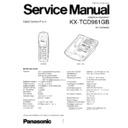Panasonic KX-TCD961GB Service Manual ▷ View online
|
43
|
KX-TCD961GB
ADJUSTMENT (BASE UNIT)
Adjustment objectives
Tools required for adjustments
Frequency counter
Personal computer
Serial communication tool
Test software (batch files)
Line simulator
Oscillator
Audio level meter
Item(1)
1. Connect the serial link to test computer to J102 (serial data) and J103 (GND).
2. Connect the AC adaptor.
3. Connect the frequency counter to TP148 (SCLK) and J103 (GND).
4. Send “SETFREQ.BAT” to set the clock frequency. The default value is 80. Increase
the value to increase the frequency. The clock frequency must be
5,184,000 Hz ±7 Hz.
Adjustment item
Symptom
Synchronization with the portable handset is lost
immediately.
No link is established.
Remedy
Perform the adjustments described in item(1).
Clock frequency
|
44
|
KX-TCD961GB
Item(2)
1. Connect the serial link to test computer for J6 (serial data) and J8 (GND).
2. Connect a 3.9V supply to the handset.
3. Press the “power on” button.
4. Set the battery voltage to 4.6V at J1 and J2.
5. Send batch file “READBATT.BAT”. The returned hex value is M2.
6. Send batch file “WRTBATT.BAT M2”.
7. Set the battery voltage to 3.46V at TP87.
8. Send batch file “READBATT.BAT”. The returned hex value is M1.
9. Send batch file “WRTBATT.BAT M1”.
10. Calculate the low value 2 level:
11. Send “WRTBATT.BAT M3”.
ADJUSTMENT (HANDSET)
Adjustment objectives
Tools required for adjustments
Frequency counter
Power supply unit (DC 3V~5V, 1A)
Personal computer
Serial communication tool
Test software (batch files)
Item(1)
1. Connect the serial link to test computer to J6 (serial data) and J8 (GND).
2. Turn off power for the base unit.
3. Input a 3.9V supply to the handset J5 (+) and J8 (GND).
4. Connect the frequency counter to TP56 and J8 (GND).
5. Connect a frequency counter between TP6 (SCLK) and J8 (GND).
6. Press the “power on” button.
7. Send batch file “FIXFREQ.BAT”.
8. Use batch file “SETFREQ.BAT” to set the clock frequency. The default value is 80. Increase the value to increase
the frequency and vice-versa. The clock frequency must be 10,368.000 kHz ± 0.02 kHz.
Adjustment item
Symptom
Synchronization with the base unit is lost immediately.
No link is established.
Remedy
Perform the adjustments described in item(1).
Clock frequency
The communication (standby) times is short.
The low battery display period is too long or too short.
Perform the adjustments described in item(2).
Low battery
M3 Dec =
M1 Dec – (M2 Dec – M1 Dec) X 0.1
4.66 – 3.46
|
45
|
KX-TCD961GB
CHECK PROCEDURE (BASE UNIT)
TEST EQUIPMENT REQUIRED AND EQUIPMENT SETUP
(a) CMD60
(b) “Bell” Oscillator: FREQUENCY: 25Hz
(c) Power Supply (12V 1A)
(d) DMM
(e) Ammeter
(f) Frequency Counter
(g) Oscilloscope
(h) Computer (PC): Set the computer to the MS-DOS mode. Type: SET_COM1.
(i) Test software (Batch Files)
Connect an 10V supply to the board J2 pin 1 (+), pin 2 (–), (or connect an AC Adaptor).
Connect the computer serial link to the Test Fixture J102 (+), J103 (–).
INITIAL POWER + BBIC TESTS
1. Turn on the 10V supply.
2. Check for approx. 70 mA current on the 10V supply.
3. Check the 4V supply voltage (TP91). It must be 3.88 ± 0.2V.
4. Check the 3.3V supply voltage (TP95). It must be 3.0 ± 0.2V.
5. Connect SCLK (TP148) to CH.1 on the scope.
6. Check if the clock waveform is 5,184,000 Hz ±7 Hz.
7. Send batch file “SELF TEST”.
SET THE CLOCK FREQUENCY
1. Send batch file “FIX FREQ”.
2. Check for approx. 90 mA current on the 10V supply.
3. Transfer SCLK (TP148) to the frequency counter.
4. Send batch file “SETFREQ nn” to set the clock frequency. The default value of nn is 80. Increase the value to
increase the frequency and vice-versa. The clock frequency must be 5,184,000 Hz ±7 Hz.
TEST MODE:
CONFIG MENU
MANUAL TEST
MODULE TEST
MODULE TEST
FP
SIGN
TRAFFIC SLOT:
TRAFFIC CARRIER:
RF LEVEL:
TRIGGER:
EXP. POWER:
RF GENERATOR
SCRAMBLE:
4
5
– 55 dBm
RISING SLOPE
30 dBm
FREQ:
DEVIATION:
SIGNAL:
RF LEVEL:
OFF
1888.704 MHz
288 kHz
01010101
– 65 dBm
|
46
|
KX-TCD961GB
QUICK Tx CHECK
1. Set the CMD60 to MODULE TEST.
2. Send batch file “H”.
3. Confidence check of Power (NTP): it must be +20 to +25 dBm.
4. Confidence check of Frequency Offset: it must be 0 ± 40 kHz.
5. Confidence check of Deviation of B field Data Type 01010101: it must be 207 to 270 kHz.
LOOPBACK TEST
1. Set the CMD60 to MANUAL TEST.
2. Set the CMD60 TRAFFIC CARRIER to 0.
3. Send batch file “TESTMODE”.
4. On the CMD60, press “SETUP CONNECT”.
5. Check the Power (NTP): It must be +20 to +25 dBm.
6. Press MODULATION.
7. Set Data Type to “Fig.36”.
8. Check the Frequency Drift: it must be 0 ± 45 kHz/ms.
9. Check the Frequency Offset: it must be 0 ± 40 kHz.
10. Send batch file “WREE 00 16 nm” to adjust the Deviation (Max. ± B Field) with Data Type: 01010101. Increase
the value nm to increase the Deviation and vice-versa. The least significant digit (m) of the value must be 1 (i.e.
only the values 31, 41, 51, 61 etc. are allowed). The Deviation must be 207 to 270 kHz.
11. Check the Deviation (Max. ± B Field) with Data Type “Fig.36”: it must be 202 to 404 kHz.
12. Press MENU UP.
13. Press POWER RAMP.
14. Check the Burst fits mask.
15. Press MENU UP.
16. Press BER.
17. Note the Sensitivity (reduce RF LEVEL for a BER of approx. 1000ppm) : the RF LEVEL must be < – 90 dBm.
18. Press MENU UP.
19. Press BEARER RELEASE.
(Note: These tests can be repeated on Traffic Carriers 5 and 9.)
Click on the first or last page to see other KX-TCD961GB service manuals if exist.

